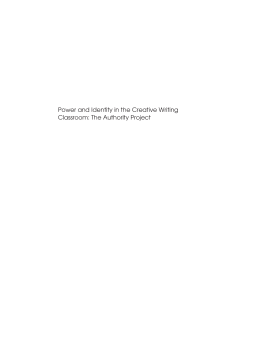
Additional Information
Book Details
Abstract
Power and Identity In the Creative Writing Classroom remaps theories and practices for teaching creative writing at university and college level. This collection critiques well-established approaches for teaching creative writing in all genres and builds a comprehensive and adaptable pedagogy based on issues of authority, power, and identity. A long-needed reflection, this book shapes creative writing pedagogy for the 21st century.
Anna Leahy is Associate Professor of English, Associate Director of the MFA in Creative Writing, and Director of Undergraduate Research and Creative Activity at Chapman University, USA. She has published widely on creative writing pedagogy, as well as creative non-fiction and poetry. She is the editor of TAB: The Journal of Poetry & Poetics.
Power and Identity in the Creative Writing Classroom, edited by Anna Leahy, serves as a fine example of this expanding, improving conversation on the teaching of creative writing. This book is generative, ranging and substantial. It is a book I wish I had read before I taught my first creative writing workshop. This is an impressive collection. Among other issues, The Authority Project addresses power dynamics in the classroom, assumptions about the roles of students and teachers in creative writing, gendering in creative writing, and how best to teach students in this complicated classroom space. To its credit, the collection provides no prescriptions. Authority, as all teachers know, is a central dynamic in the classroom, and this collection should be of use to creative writing teachers and others who want to learn more about it.
Table of Contents
| Section Title | Page | Action | Price |
|---|---|---|---|
| Contents | v | ||
| Acknowledgements | vii | ||
| Foreword | ix | ||
| Part 1 Understanding the Larger Influences | 1 | ||
| Chapter 1 Personal Therapeutic Writinf vs. Literary Writing | 3 | ||
| Chapter 2 Who Cares - and How: The Value and Cost of Nurturing | 13 | ||
| Chapter 3 Inspiration, Creativity, and Crisis: The Romantic Myth of the Writer Meets the Contemporary Classroom | 26 | ||
| Chapter 4 Reinventing Writing Classrooms: The Combimation of Creating and Composing | 39 | ||
| Chapter 5 The Double Bind and Stumbling Blocks: A Case Study as an Argument for Authority-conscious Pedagogy | 49 | ||
| Part 2 The Teacher's Place, Voice, and Style | 63 | ||
| Chapter 6 Teaching and Evaluation: Why Bother? | 65 | ||
| Chapter 7Who's the Teacher?: From Student to Mentor | 77 | ||
| Chapter 8 The Pregnant Muse: Assumptions, Authority, and Accessibility | 87 | ||
| Chapter 9 Dismantling Authority: Teaching What We Do Not Know | 98 | ||
| Part 3 Course Design | 107 | ||
| Chapter 10 Contracts, Radical Revision, Portfolios, and the Risks of Writing | 109 | ||
| Chapter 11 'A' for Effort: How Grading Policies Shape Courses | 121 | ||
| Chapter 12 Gender and Authorship: How Assumptions Shape Perceptions and Pedagogies | 130 | ||
| Chapter 13 Writing in the Community: Service Learning in Creative Writing | 141 | ||
| Part 4 In the Classroom | 153 | ||
| Chapter 14 Where Do You Want Me To Sit?: Defining Authorty through Metaphor | 155 | ||
| Chapter 15 Duck, Duck, Turkey: Using Encouragement to Structure Workshop Assignments | 167 | ||
| Chapter 16 How to Avoid Workshop Dilemmas: The Use of Myth to Teach Writerly Concepts | 180 | ||
| Chapter 17 Writing in the Shadows: Topics, Models, and Audiences that Focus on Language | 192 | ||
| Afterword | 203 | ||
| The Reason It Is; the Rhyme It Isn't | 205 | ||
| About the Authors | 215 |
